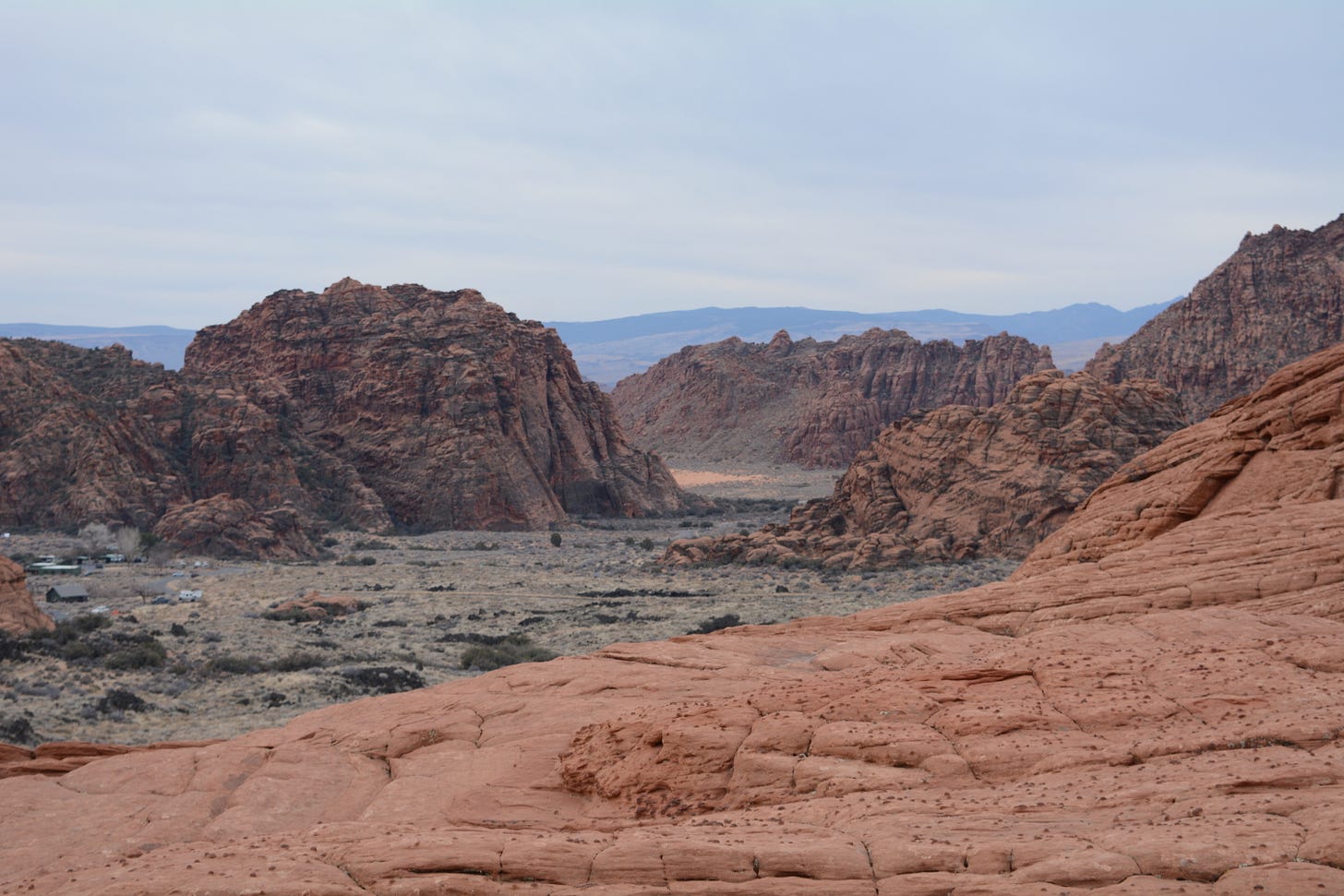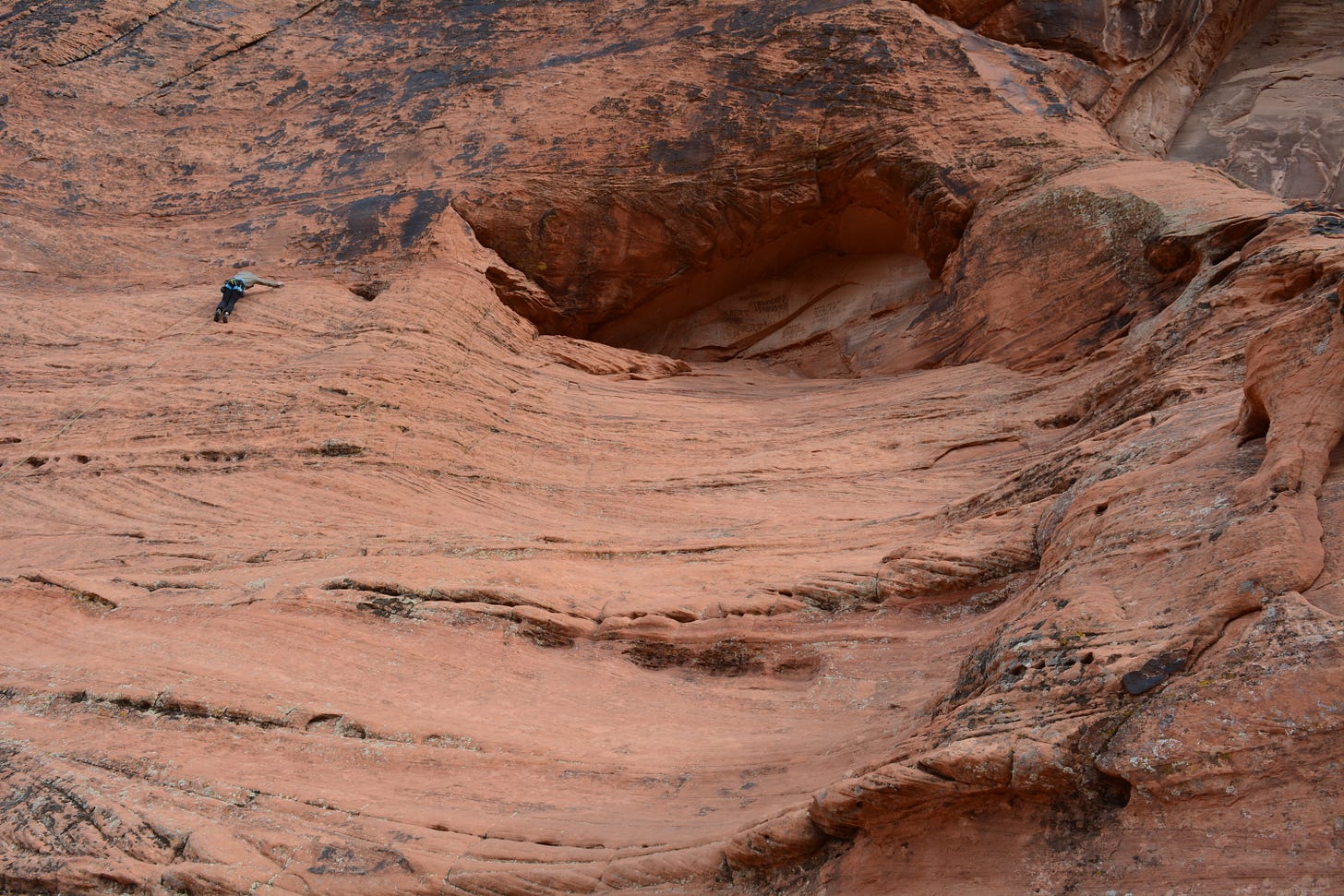“Whosoever is delighted in solitude, is either a wild beast or a god”
- Francis Bacon (paraphrasing Aristotle)
Providing the roads are clear, January is a great time for adventure in southern Utah. It’s deep into the off season and still kind of cold, but never as cold as home is. You can get a hotel room or campsite with little to no lead time.
So, on a Friday afternoon we load the kids into the car and drive a few hours south. Our destination is St. George and Snow Canyon State Park.
One of the first designated state parks in Utah, Snow Canyon was established in 1958 and opened in 1962. It was originally known as Dixie State Park, but the name was changed in honor of Lorenzo and Erastus Snow after the state acquired a few thousand additional acres of federal land in 1964.
Snow Canyon is a hidden gem. The scenery is as beautiful as any you would find in a National Park, and the many of the hiking areas allow for rather free exploration. If you’ve ever run the St. George Marathon (which I did twice, but have since sworn a Homeric oath to never do again) then you have seen Snow Canyon. I don’t feel bad disclosing this location, because anyone coming to the area from far away is going to spend their time elsewhere: Zion National Park or Las Vegas. And if any locals don’t know about it, they should.
First thing on Saturday morning we hit the park, joining up with some friends for a few hikes. It is nearly deserted, and we take the kids out to scramble around on the petrified sand dunes and look for tortoises. (The tortoises are hibernating, but the kids don’t need to know that.) Most of the cars we see are from Utah or adjoining states. Most of the people are more Carhartt than Patagonia.
For lunch we drive to the IceBox Grill in Ivins, a sleepy little town at the foot of Red Mountain that is quickly being gobbled up by resort communities that look like simulacra of desert towns complete with foreign cactus and palms. The pastrami burger is good.
The family goes back home with our friends, so the kids can play, and I return to the canyon. I drive up the road, undecided about where to spend my afternoon.
I see the sign for the Pioneer Names trail and pull over. A short hike across a dry creek bed leads to the cliff side. Two sets of rock climbers are making their way up the rough orange stone. One man is posed beside the alcove that is littered with writing in disparate stages of fading:
1919 SAM GUBLER
SAMUel WittWeR
ALBERT GRAF. OCTOBER, 18th 1898
JACOB GUBLER AUG.30.1887
HARMAN GUBLER. MARCH 4, 1881
More recent spray paint has been scrubbed off the rock, some less successfully. One wonders what makes Dave & Robert unworthy, but not Harman.
Back in the car I open my map to pick out my next hike. I spot one that I hadn’t seen on the park website, one that cuts west across the narrow valley and ends among the steep cliffs. I drive to the trailhead.
The first stretch—across a mix of loose sand and jagged lava rock—climbs through a ravine crowded with shrub oak. Were it not for the acorn caps littering the ground beneath the bushes, they might be confused for a dwarf desert variety of holly: their evergreen leaves are small and tipped with spikes. The trail opens up to muted green shrubs and grasses that burst through contrasting sand. I climb up sandstone slabs to a ridge that runs to the north. A group of hikers approaches.
“Howdy,” I say, using the only acceptable greeting on a western trail.
The leader of the group—a slender guy in his 50s with wireframe glasses and the look of an aerospace engineer or an actuary, you know the type—brushes off my gesture and asks a question.
“What trail do you think you’re on?”
I’ve never been asked such a question before. It sounds like a trick, or perhaps I’m meant to settle a dispute and silence the dissenters in his expedition. I know what trail I’m on. I answer him. He grunts and keeps walking.
The rest of the group follows with one guy offering a “have a nice day.”
I move on and at a fork, my trail splits and drops down from the ridge. I run into another party, this one friendly, and pass some pleasantries with a young man in full cowboy getup who comments on my camera.
“I bet you get some pretty good pictures with that.”
“It’s hard not to in a place like this.”
At the bottom of the hill I cross a wash, then a narrow road that runs the length of the canyon. The trail continues in loose sand, eventually merging with an arroyo. From here on out I don’t see any more people.
The longer I spend in the wilderness, the deeper I go, the less I want to see another person and the more I view an encounter with suspicion. Solitude is what I had hoped to find in the few short hours I have to myself, and this trail provides it. The dry creek bed is studded with hundreds of dents, remnants of human footfalls, but no boot treads are visible. They could have been made an hour ago or a month. On the banks, wind-carved ripples are marred only by the light steps of birds and rodents.
The arroyo twists past sentinel cliffs and deeper into canyon country. The going is hard, with no firm ground underfoot for what seems like miles. I brought water, but not enough that I don’t feel the need to ration it.
At a sharp bend I find a flat red and white striped rock to rest on. I drink and pause to listen to my surroundings. There is nothing.
My ears search for familiar sounds. Traffic, none. Airplanes, none. Birds, none. Insects, none. There is not so much as the slightest gust of wind to rattle dead leaves that cling to the trees and bushes. All I hear is a steady high-pitched hiss in my ears that feels like the decaying signal of a civilization that exists solely for itself; never sleeping, always screaming. Part of me knows that what I hear is my own hearing, dying. But part wonders whether—if given enough time—I could sit here until it faded away to true silence.
I consider closing my eyes and meditating for a while, but I fear turning inward amidst such strangeness. I remember the time I went on a tour of the Cave of the Winds outside of Colorado Springs. At one point, as in all good cave tours, we turned out our lights to experience the complete darkness. The guide said that those who have found themselves trapped in such circumstances will begin to hallucinate vividly, as the unconscious brain becomes desperate for inputs for the unneeded sense. What does one find when confronted with prolonged deprivation?
The unprepared will slip into madness. The prepared will hear God.
I do not feel prepared.
After another quarter mile, I find the end of the trail. A sign stands beside a small pool containing a few gallons of fetid water: the last remains of the last storm that sent water pouring over the break in the sandstone wall above. Getting through looks like more of a scramble than I’m looking for, but to the side, something of a slot canyon is visible through the oak.
I enter…
Back in town later that night, I pull into the Smiths parking lot. I need to pick up some diapers and road-trip snacks. For a minute, I watch the shady characters who have accumulated around the periphery. ICE hasn’t found St. George yet.
I step out of the car. I feel feral.









